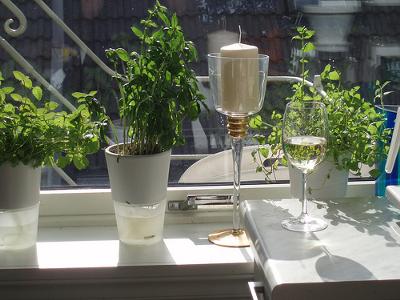Grow Your Very Own Herbal Garden For The Kitchen
by Michelle Ann Gelder
(Houston,Texas)

Wouldn’t it be awesome to have your very own fresh herbs right in your kitchen when it’s time to cook? There’s nothing tastier or healthier than using truly fresh herbs in your cooking and nothing is as rewarding as growing something that you can use. This is all aside from the fact that home grown herb gardens can save you a substantial amount of grocery money. While it does take a little money to start your garden, it will pay for itself in your first harvest.
Which Herbs do you use the Most?
Making decisions about which herbs to grow should be based on which herbs you will want to use the most of. Some cooking herbs that do exceptionally well inside are thyme, oregano, sage, parsley, and chives. Mint is another herb that does very well inside, but make sure you plant it in its own container or it will quickly over-take other herbs. Garlic does well inside and is one of the most used herbs in the world.
Seeds or Plants, Which is Best?
Seeds are the least expensive choice but they take more time and effort. They are available for practically any type of herb you want to grow. You may want to peruse local nurseries to see what they have available and get a good idea of the price ranges, they can also assist you with the requirements for each individual plant. Also pay attention to whether you are collecting annuals or perennials and be sure and plant them with that information in mind.
Which Containers Should you Use?
You have many choices for the type of garden you want. Many considerations must be made as to the space you have available for your garden. You can choose to use one large container or several small ones according to your preferences. If you choose to use one large container, be sure to make your plants far enough apart so they don’t become entangled with each other and sometimes they can exchange some flavors. On average, you will need to leave six to eight inches between the plants. Individual pots that are approximately six inches across may be the more practical choice. This will allow you to populate many window sills with pretty little plants which will use less space.
Soil and Aeration
Most successful herb gardeners will tell you they have had the best luck with sterilized soil with very coarse sand, both are available at nurseries, large variety stores and most hardware stores. You will want loose soil that will drain well. For proper aeration it is a good idea to add some stones to your containers to help them drain better.
Some other Tidbits
If you choose seeds, be sure to read the package instructions. Not all herbs are planted at the same depth or require the same amount of water. Each plant needs to be treated as an individual, even of you choose to use one large container. If you use seedlings from a nursery be sure to keep the little plant spikes to remind you which herb is which and heed the instructions on the spike for the plants. There is a wealth of information on those little spikes that can determine the success of your garden. You will need to have a spray bottle with a fine mist, as most herbs need to be misted often. Above all, have fun with your garden!
Spending time in the kitchen is what Michelle loves doing best and preparing vegetarian crock pot recipes or crock pot soup recipes. Crock pots are a great way to minimize the time you need to spend in the kitchen so head over to a-crock-cook.com for more delicious ideas.